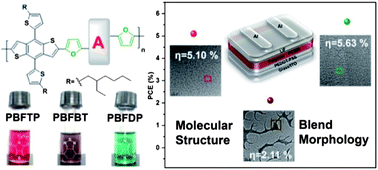Correlation between structure and photovoltaic performance of a series of furan bridged donor–acceptor conjugated polymers†
Abstract
A series of donor–acceptor (D–A)

* Corresponding authors
a
Institute of Functional Nano & Soft Materials (FUNSOM), Jiangsu Key Laboratory for Carbon-Based Functional Materials & Devices, Soochow University, 199 Ren'ai Road, Suzhou 215123, China
E-mail:
wlma@suda.edu.cn
A series of donor–acceptor (D–A)

 Please wait while we load your content...
Something went wrong. Try again?
Please wait while we load your content...
Something went wrong. Try again?
J. Yuan, Z. Zhai, J. Li, J. Lu, X. Huang, Z. Xu and W. Ma, J. Mater. Chem. A, 2013, 1, 12128 DOI: 10.1039/C3TA12210G
To request permission to reproduce material from this article, please go to the Copyright Clearance Center request page.
If you are an author contributing to an RSC publication, you do not need to request permission provided correct acknowledgement is given.
If you are the author of this article, you do not need to request permission to reproduce figures and diagrams provided correct acknowledgement is given. If you want to reproduce the whole article in a third-party publication (excluding your thesis/dissertation for which permission is not required) please go to the Copyright Clearance Center request page.
Read more about how to correctly acknowledge RSC content.
 Fetching data from CrossRef.
Fetching data from CrossRef.
This may take some time to load.
Loading related content
